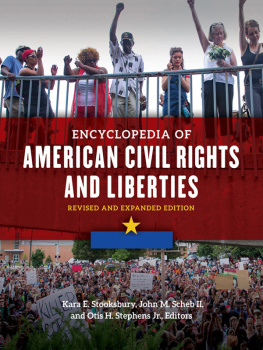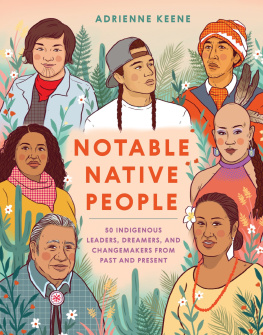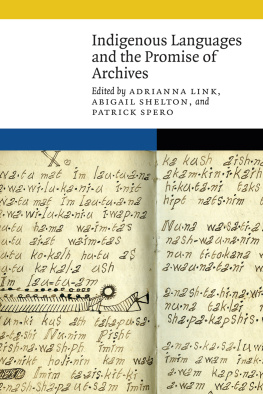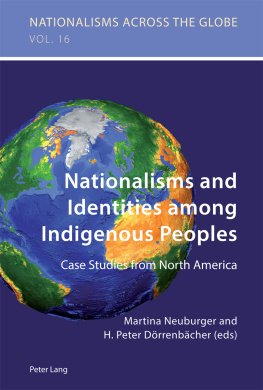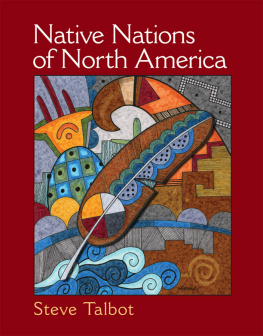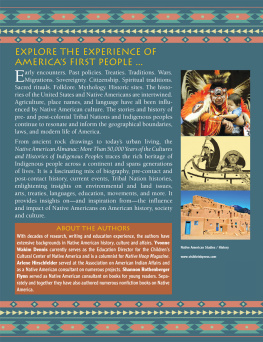Say We Are Nations
This book was published with the assistance of the H. Eugene and Lillian Youngs Lehman Fund of the University of North Carolina Press. A complete list of books published in the Lehman Series appears at the end of the book.
2015 The University of North Carolina Press
All rights reserved
Designed by Alyssa DAvanzo
Set in Calluna by codeMantra, Inc.
Manufactured in the United States of America
The paper in this book meets the guidelines for permanence and durability of the Committee on Production Guidelines for Book Longevity of the Council on Library Resources.
The University of North Carolina Press has been a member of the Green Press Initiative since 2003.
Cover illustration: Ariana Chavis, Recognition, Part 1. Used with permission.
Library of Congress Cataloging-in-Publication Data
Cobb, Daniel M., compiler.
Say we are nations : documents of politics and protest in indigenous America since 1887 / Daniel M. Cobb.
pages cm. (H. Eugene and Lillian Youngs Lehman series)
Includes bibliographical references and index.
ISBN 978-1-4696-2480-8 (pbk : alk. paper) ISBN 978-1-4696-2481-5 (ebook)
1. Indigenous peoplesUnited StatesSocial conditionsSources. 2. Indigenous peoplesLegal status, laws, etc.United StatesSources. 3. Indigenous peoplesUnited StatesGovernment relationsSources. 4. Indigenous peoplesCivil rightsUnited StatesSources. 5. Indigenous peoplesUnited StatesPolitics and governmentSources. I. Title. II. Series: H. Eugene and Lillian Youngs Lehman series.
E93.C66 2015
323.1197073dc23
2015010506
To Kevin Swope and Jason Stiffler, friends and heroes
Contents
Map and Figures
MAP
Indigenous America, 2015
FIGURES
Queen Liliuokalani
Fred Fast Horse
Committee of One Hundred
Workshop on American Indian Affairs
Poor Peoples Campaign
Alcatraz
Wilma Mankiller and Phillip Martin
Russell Jim
Faith Spotted Eagle
Acknowledgments
I traveled a long road in completing this book and accumulated many debts along the way. A Lester J. Cappon Fellowship in Documentary Editing in the summer of 2009 afforded an opportunity to draft the proposal and identify documents in the rich collections of Chicagos Newberry Library. Presentations at Helsinki Universitys Maple Leaf and Eagle Conference in North American Studies, Stockholm University, and Dartmouth College in 2010 provided settings for me to work through my initial thoughts on the topic. An invitation to contribute a chapter to the edited volume Native Diasporas pushed me to clarify my thinking in regard to the assertion of a global indigenous identity in the context of Native activism before and after the Cold War. For these opportunities, I thank Allan Winkler, Markku Henriksson, Clara Sue Kidwell, Bo Persson, Gunlg Fur, Ben Madley, Colin Calloway, Gregory Smithers, and Brooke Newman. The History Department at Miami University and the Department of American Studies and Center for Global Initiatives at the University of North Carolina generously supported my international travels.
In my first year at the University of North Carolina, I developed an upper-division, research-intensive course on Native politics and activism since 1887 inspired by and founded on the material I had identified for this volume. Students selected primary documents and spent the better part of the semester transcribing and conducting the research necessary to contextualize them. I believe there is no better way for teachers to encourage student engagement than to involve them directly in what we are most passionate aboutto invite them to be co-creators of new knowledge. Thats exactly what my students have become each time Ive taught the course. They have challenged me to think about Native activism in a different light, and their unique interests caused me to pursue themes and avenues of investigation that I would not have otherwise. So, to the approximately seventy-five scholars who have gone Beyond Red Power with me since 2010, I say thank you for being outstanding students and teachers. A special note of gratitude is due to Ariana Chavis for graciously allowing me to use her original work, Recognition, Part 1, as the cover art.
I was also fortunate in being able to call upon colleagues for assistance in tracking down documents I had encountered in reading their brilliant work. My gratitude goes to John Troutman, Christian McMillen, Tisa Wenger, Katherine M. B. Osburn, Keith Richotte, J. Khaulani Kauanui, Jean Dennison, and Jacqueline Solis in this regard (even though some of the documents didnt make it into the volume). Thanks, too, to Cindy Kelly, president of the Atomic Heritage Foundation, Barbara Leigh Smith of Evergreen State College, Chickasaw legal scholar Alex Pearl, and Din poet, musician, and activist Lyla June Johnston for granting permission to include excerpts from the Russell Jim interview, Osage constitution case study, 3/256, and Call Me Human, respectively. Dave Posthumus provided invaluable service by transcribing and translating the Lakota language used by Armando Iron Elk and Faith Spotted Eagle in chapter 5. I thank Bill Wingell and Jason Kaplan, too, for allowing me to include their photographs of the Alcatraz occupation and Yakama elder Russell Jim. Maureen Booth, Jennifer Klang, Shyamalika Ghoshal, and George Franchois of the U.S. Department of the Interior Library delivered critical assistance at a rather late hour, as well.
In researching and writing about the 1960s, my life has been made much richer by virtue of getting to know many of the people who made that history. More meaningful still have been the ongoing relationships, some of which are now more than a decade old. I am particularly thankful for Jeri (Cross) Redcorns and Sandra (Johnson) Osawas willingness to let me include the words they wrote as college students attending the Workshop on American Indian Affairs. Angela Russell graciously permitted me to include her reflections on participating in the Selma-to-Montgomery March originally published in Americans before Columbus. Della Warrior has always been generous, sharing her life experiences and personal papers with me. In addition to leading to the inclusion of Clyde Warriors words in this volume, my relationship with her set the next destination of my intellectual journey, a biography of her late husband.
Mark Simpson-Vos, editorial director of the University of North Carolina Press, has been a stalwart supporter of this project from its inception all the way through to its completion. I am so very thankful for his patient encouragement and keen insights over the years. The readers of this volumes prospectus and earlier iterations provided critical feedback and were instrumental in streamlining its organization, sharpening its focus, and correcting at least one bad date. Any errors that remain are my responsibility alone.
The five years it took to write Say We Are Nations taught me the truth of this insight. I thank my wife, N. Nicole Cobb, and my daughters, Anna and Molly, for once again understanding the demands of my solitary craft. As they have always done, my parents read and offered critical feedback on every word of every page. And my dad, a skilled anthropologist whose interest in Native America inspired my own, is the someone referred to in the introduction who read all of these documents aloud the second time so I could check the transcriptions for accuracy.
Say We Are Nations
Introduction
A Reflexive Historiography
Over the past several decades, reflexivity has transformed the field of anthropology. It began as a critique of the ethnographic method, but I consider the concerns it raises applicable to any scholarly enterprise. Essentially, reflexivity refers to the process of consciously locating ourselves in the work we create. Reflecting on our positionality allows us to think critically about the intersubjectivity of the stories we tellto recognize that there is an awful lot about us in what we write about them (no matter who the us or them happen to be). The importance of reflexivity to scholarship about the past has not been lost on historians. In fact, even Frederick Jackson Turner, propounder of the infamous frontier thesis in 1893, recognized that theres a lot about now in what gets written about then. When... we consider that each man is conditioned by the age in which he lives and must perforce write with limitations and prepossessions, he observed in 1891, I think we shall all agree that no historian can say the ultimate word. One would like to think that this self-awareness would have injected Turner with a dose of humility. It didnt.
Next page



